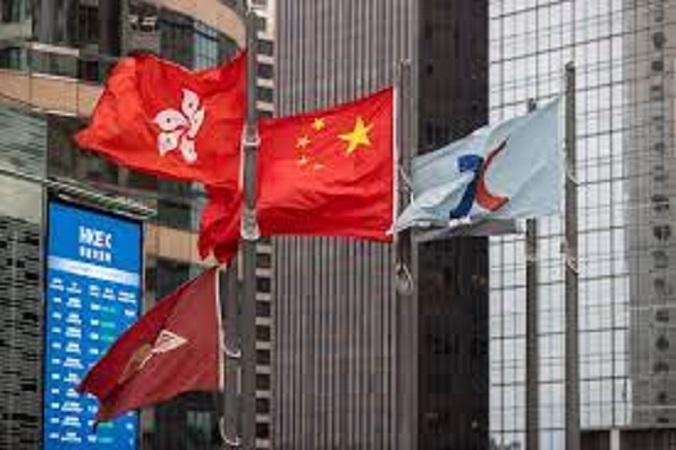
Hong Kong’s Hang Seng Index plummeted by 13.2% on April 7, 2025, marking its worst single day drop since the 1997 Asian financial crisis. The index closed at 19,828.30, shedding 3,021.51 points, as a wave of panic selling gripped the market. This steep decline erased significant market capitalization and reflected a broader collapse in investor confidence, driven by escalating global trade tensions and recession fears. The crash was triggered by China’s retaliatory tariffs against U.S. levies, intensifying a trade war between the world’s two largest economies. Beijing imposed 34% duties on all U.S. goods, effective April 10, in response to sweeping U.S. tariffs announced earlier.
This tit-for-tat escalation rattled markets, with Hong Kong—a free port heavily tied to global trade—bearing the brunt. All 83 stocks in the Hang Seng Index declined, with tech giants like Alibaba (down 18%) and JD.com (down 15.5%), alongside banks like HSBC (down 15%), leading the losses. The Hang Seng Tech Index fared even worse, dropping 17%—its largest single-day fall on record. Globally, the fallout was swift. Mainland China’s CSI300 Index fell 7%, despite state-backed intervention from Central Huijin, while Japan’s Nikkei 225 slid 7.8% and Taiwan’s market tanked 9.7%.
Commodity prices, including oil and iron ore, also tumbled as fears of a global slowdown mounted. The Hang Seng Volatility Index surged to its highest level since March 2022, signaling heightened uncertainty. Historically, the Hang Seng has seen sharp drops before—most notably in October 1997, when it fell over 10% amid the Asian financial crisis and Hong Kong’s handover to China. That year, it ended at 10,722 after peaking at 16,673. recent declines, however, stands out for its speed and scale, pushing the index to its lowest since January 23, 2025. Unlike 1997, when currency pressures and regional contagion dominated, this plunge is tied to trade war dynamics and China’s faltering economic momentum—exacerbated by deflation, a property crisis, and no major stimulus in sight.
Register for Tekedia Mini-MBA edition 19 (Feb 9 – May 2, 2026): big discounts for early bird.
Tekedia AI in Business Masterclass opens registrations.
Join Tekedia Capital Syndicate and co-invest in great global startups.
Register for Tekedia AI Lab: From Technical Design to Deployment (next edition begins Jan 24 2026).
The immediate trigger may have been tariffs, but underlying vulnerabilities in Hong Kong’s market, long leveraged to China’s growth, amplified the rout. With the index down 27% in a month, erasing gains from earlier in the year, questions loom about whether this is a short-term panic or the start of a deeper bear market. For now, the financial hub faces a critical test of resilience as global eyes turn to Beijing’s next move.
Hong Kong’s economy, already strained by years of political unrest and a post-COVID slowdown, faces a severe hit. The crash slashes corporate valuations, tightens liquidity, and threatens the city’s status as a global financial hub. Small and medium enterprises, reliant on stock market sentiment for funding, could see investment dry up. Retail investors, a significant force in Hong Kong’s market, suffer massive wealth losses. This could curb consumer spending, deepening deflationary pressures and slowing recovery in sectors like retail and real estate, where prices were already softening.
Major banks like HSBC and Standard Chartered, which saw double-digit drops, may face increased loan defaults and reduced profitability. Their exposure to mainland China and global trade amplifies the risk, potentially necessitating tighter lending standards. The crash heightens scrutiny on Hong Kong’s government and its Beijing-backed leadership. With economic woes compounding social tensions, calls for policy intervention—beyond reliance on mainland support—could grow, though autonomy remains limited.
Regional Implications
The Hang Seng’s collapse mirrors and magnifies mainland China’s CSI300 drop of 7%. As a barometer of Chinese economic health, Hong Kong’s rout signals deeper trouble in Beijing’s orbit—property woes, deflation, and trade war fallout—potentially forcing more aggressive state intervention. The contagion has already spread, with Japan’s Nikkei falling 7.8% and Taiwan’s market down 9.7%. Export-dependent economies in Southeast Asia, like Singapore and South Korea, could see reduced demand from China and heightened volatility in their own indices.
China’s retaliatory 34% tariffs on U.S. goods, sparking this crash, risk entrenching a broader regional trade conflict. Asian supply chains, heavily integrated with both powers, face disruption, particularly in tech and manufacturing hubs like Taiwan and Vietnam. The Hang Seng’s plunge has triggered a global sell-off, with U.S. futures, European indices, and emerging markets all sliding. Investors may shift to safe-haven assets like gold or U.S. Treasuries, driving up their yields and further pressuring equities. Declines in oil, iron ore, and other commodities reflect fears of a China-led global slowdown. Resource-rich nations—Australia, Canada, Russia—face export revenue losses, while energy markets brace for oversupply if demand falters further.
Multinational firms with heavy exposure to China and Hong Kong, from luxury brands (e.g., LVMH) to tech giants (e.g., Apple), could see revenue hits. Supply chain delays and weaker consumer demand may force profit downgrades. The U.S.-China trade war, now a central driver of this crash, risks escalating beyond tariffs into broader economic decoupling. This could reshape global alliances, with nations forced to pick sides or navigate heightened uncertainty. A sustained downturn could erode Hong Kong’s edge over rivals like Singapore as Asia’s premier financial center. Capital flight and talent exodus, already concerns since 2019’s protests, might accelerate if confidence doesn’t rebound.
Beijing may rethink its approach—balancing trade retaliation with domestic stabilization. A weaker Hong Kong could push more focus on Shanghai or Shenzhen, though neither yet matches the city’s international clout. If this crash signals a tipping point for China’s economy, it could drag the world into recession. The IMF and World Bank may revise growth forecasts downward, with central banks like the Federal Reserve facing pressure to adjust rates despite inflation concerns. Markets remain on edge, with the Hang Seng Volatility Index at a three-year high. The next few days hinge on China’s response—whether through tariff rollback, stimulus, or market support—and U.S. countermeasures.



